
13 June 2023
By Tim Koch
Tim Koch goes shopping for a piece of rowing history.
When I started rowing in Hammersmith, West London, in the mid-1980s, various old pictures on the wall of my club, Auriol Kensington (AK), showed a large and impressive boathouse dominating the waterfront at Hammersmith. It had been demolished about fifteen years prior to my arrival and replaced with unimpressive modern flats but old AK members told me that the boathouse had been the home of many different rowing clubs over the long years of its existence.
The building had originally been erected in the 1850s as “Biffen’s Metropolitan Boathouse.” Biffen’s were a firm of local boat builders that had been operating since the early 19th Century originally making boats for local fishermen. In 1897, most of the premises had been acquired for the West End Amateur Rowing Association (WEARA), a grouping of rowing clubs associated with businesses (mostly department stores) based in London’s West End shopping district and City financial district. From then, Biffen’s Boathouse was known as the West End Boathouse.
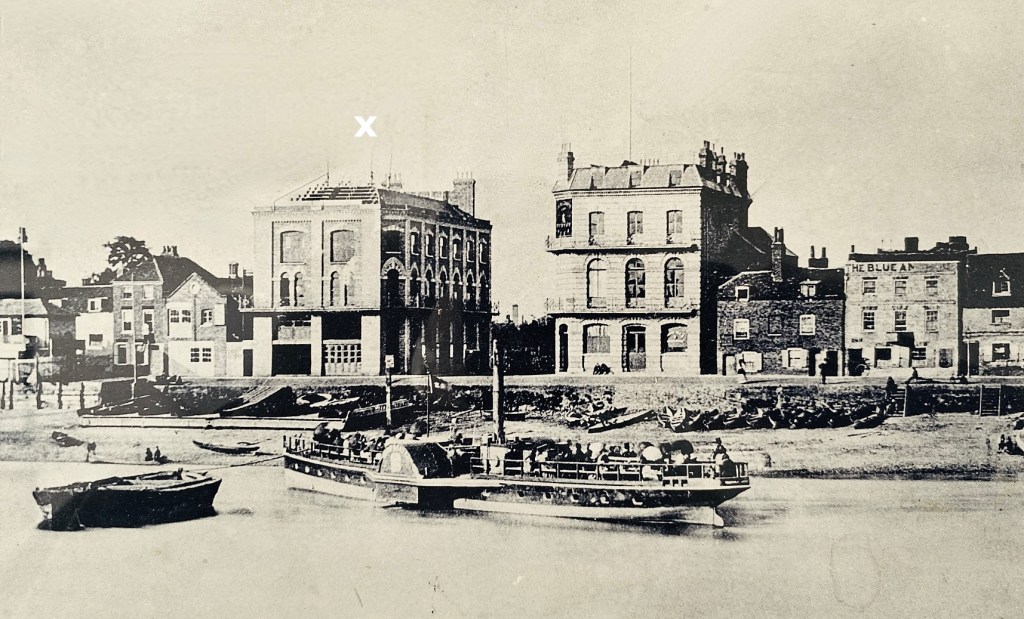

It is often the case that it takes two or three generations to build up a family business and two or three generations to run it down and this is what happened to Biffen’s. In 1897, the fourth generation put most of the Metropolitan Boathouse at 16 Lower Mall up for sale at a price of £3,600. The Biffen’s retained some rooms at the rear of the building and also the Anchor Boathouse at 14 Lower Mall (now Auriol Kensington RC) but most of the premises was bought by the West End Boathouse Co Ltd who let it to the West End Amateur Rowing Association. The Boathouse Company had successfully sold 4,000 £1 shares.
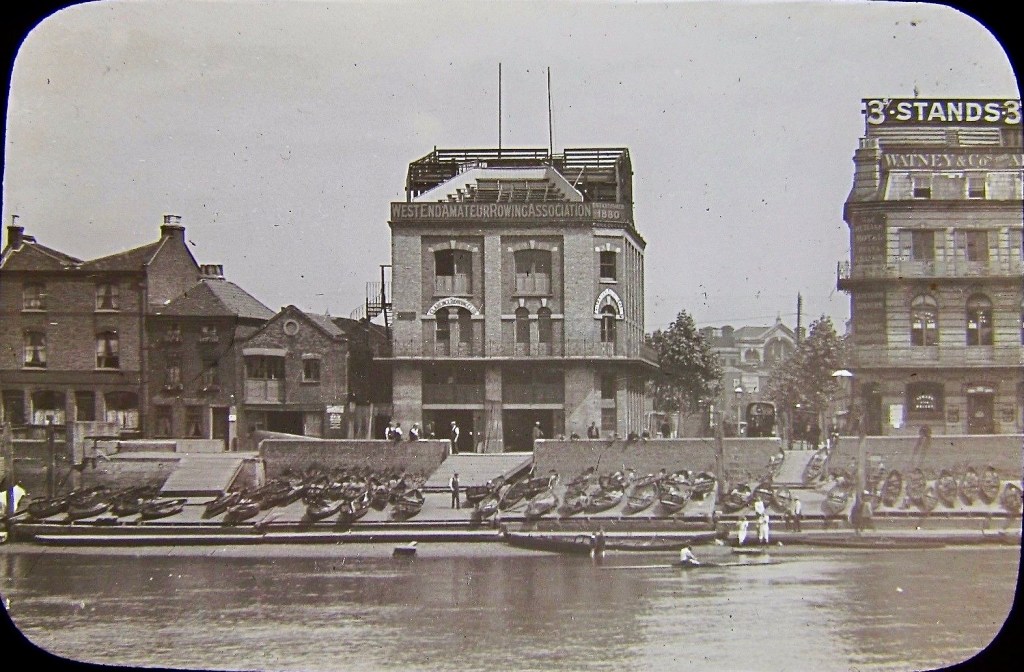
Before looking into the WEARA and the West End Boathouse, some background may be necessary. In the unlikely event that there are any young people reading this, I should briefly explain some concepts that may be strange to them, notably the idea of a paternalistic employer and also the act of shopping by visiting a bricks and mortar department store.
Paternalistic Employers
In the past, employers may have paid low wages, set long hours and discriminated at will but they could also provide a job for life (perhaps from the ages of 14 to 65) and a relatively decent pension at the end. Further, many offered free or heavily subsidised canteens and sporting, cultural and social facilities — including providing or supporting staff rowing clubs. Nowadays, the workplace is less discriminatory and working conditions are better, but there is also less job security, pensions are not what they were and there are certainly no company rowing clubs.
A look at the 1898 Rowing Club Directory of Great Britain gives a random snapshot of some tradesmen’s clubs set up for the employees of various London businesses at that time: Arundel Rowing Club (Employees of WH Smith and Son, Newsagents); Broadwood Rowing Club (Broadwood and Sons, Pianoforte Manufacturers, Soho); Caxton Rowing Club (Clowes and Son, Printers, Charing Cross); Comyns’ Rowing Club (Comyns and Sons, Silversmiths, Beak Street); Daly’s Rowing Club (Daly’s Theatre, Leicester Square) and Middlesex United Rowing Club (Monro Fruit Sales, Covent Garden).
Even when I started rowing on the Thames Tideway in the mid-1980s, there was still an annual Head Race for the surviving “Business Houses.” I recall that clubs entered in this event included Barclays Bank, Midland Bank, National Westminster Bank, Cygnet (Civil Service men), Civil Service Ladies, London Transport District Line, London Transport Buses, Horseferry (Gas Board), Lensbury (Shell) and Ibis (Prudential Insurance).
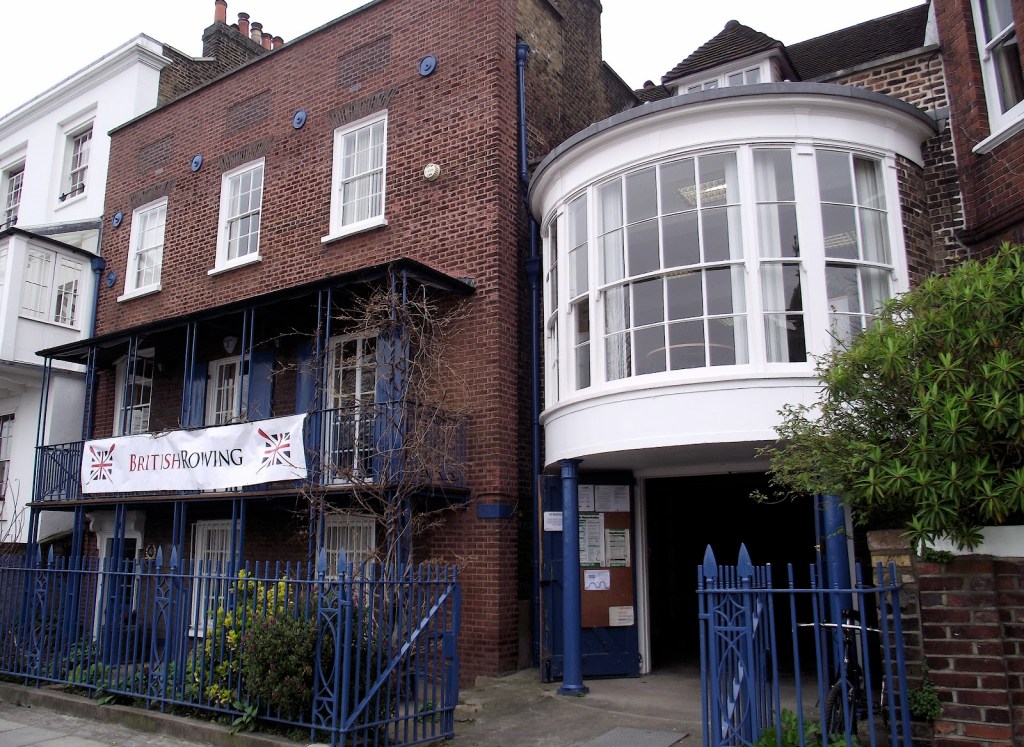
The Midland Bank RC (now called HSBC RC), Civil Service Ladies RC (now Barnes Bridge Ladies RC) and Cygnet RC today operate as open clubs with a slightly subsidised membership for employees of the founding organisations. The rest of the “Business Houses” are gone.
Addendum: On the day after I finished this article, I found that the freehold of the HSBC boathouse is for sale for £1m. Presumably the rowing club currently has some sort of lease, but this cannot bode well for its future. Also, the sales literature has used one of my pictures from the 2023 Women’s Head without asking.

Harrods department store provides a notable example of the largesse once common among employers. In 1904, Harrods built a sports club in 25-acres of grounds in Barnes, SW London, near the river, with a palatial clubhouse “for the mental and physical betterment of Harrods’ employees.” HTBS has previously posted about the club in a piece on the Harrodian Rowing Club:
The social club was quite a set-up. Formerly a country house with fourteen acres of grounds, the original building was demolished to make way for what was then a state of the art club house with its own theatre and dance hall, billiards and table tennis rooms, eight hard tennis courts, four grass courts, two football pitches, two rugby pitches, an outdoor swimming pool and a forty-seat restaurant. Harrods staff paid nothing for the use of these facilities.
By 1988, employers had no such quaint concerns about “the mental and physical betterment” of their employees and the Harrodian Club grounds and buildings were sold off.
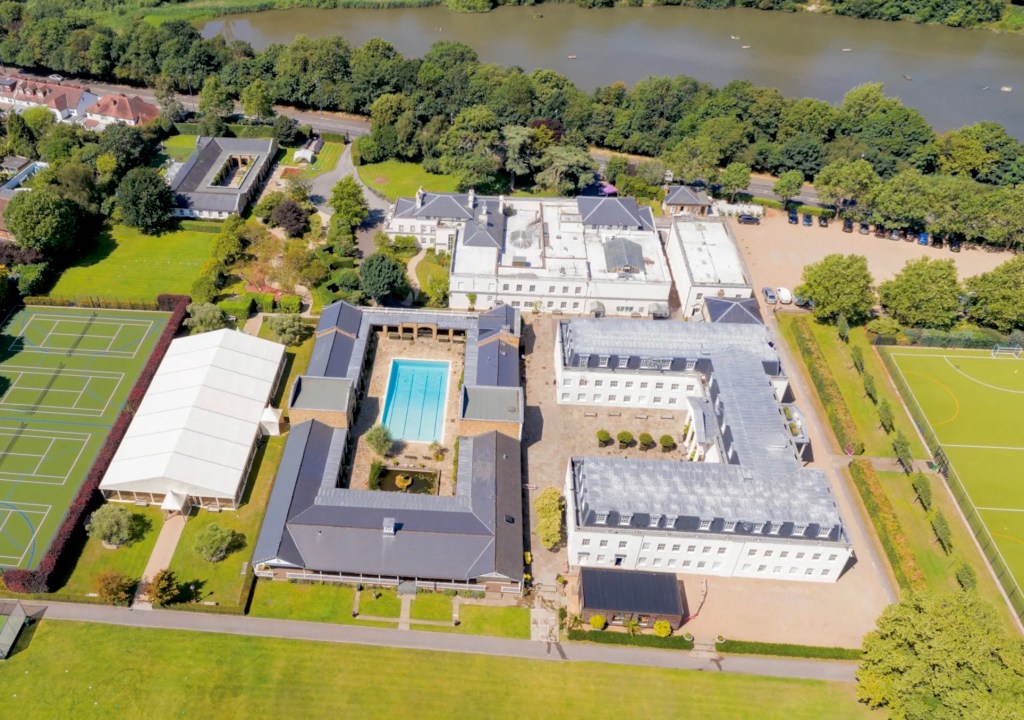
Shell Oil was another example of an employer that was once generous to its staff when it came to sporting and social matters. The Wikipedia page of the Lensbury Club says:
The Lensbury Social and Athletic Club was established in 1920 as a sports club for Shell staff… Land was acquired in Broom Road, Teddington (a suburb of south-west London), for playing fields and within a year, there were active sections in Cricket, Rugby, Football, Rowing, Ladies Hockey, Tennis and Chess…. In 1938, a new clubhouse was opened which comprised 162 bedrooms, a dining room, a ballroom and many other facilities…
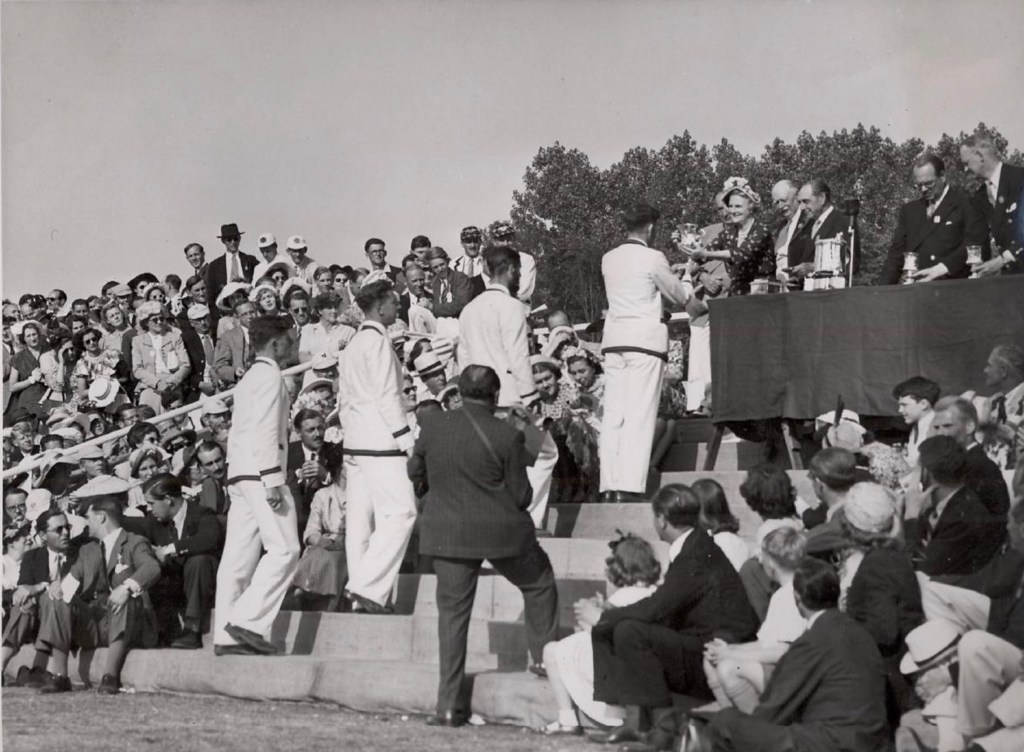
In the 1970s, Lensbury had active sections in forty-seven sports and pastimes as well as its core rowing, football, cricket and rugby teams. However, by the 1990s, Shell decided that Lensbury should be seen not exclusively as a “staff benefit” but more as a “profit centre” and opened its membership to non-Shell employees.
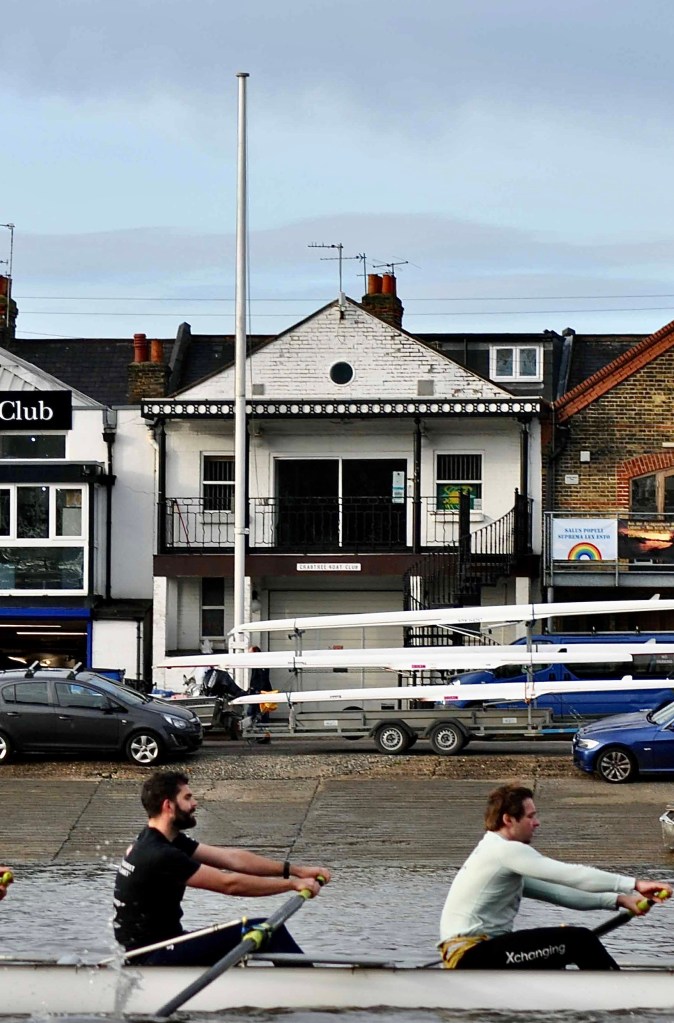

Department Stores
Shopping “offline” by physically going to large stores selling a huge variety of items still happens at a few remaining “high end” shops such as Harrods, but many people will be unaware of how ubiquitous department stores once were. There were the famous shops in London’s West End but there were also more obscure ones in most British towns and suburbs that were only known locally. In August 2021, a survey for the BBC found that over eighty percent of British department stores had closed since 2016, a decline that was the result of e-commerce and changes in consumer spending habits but one that was accelerated by the pandemic.
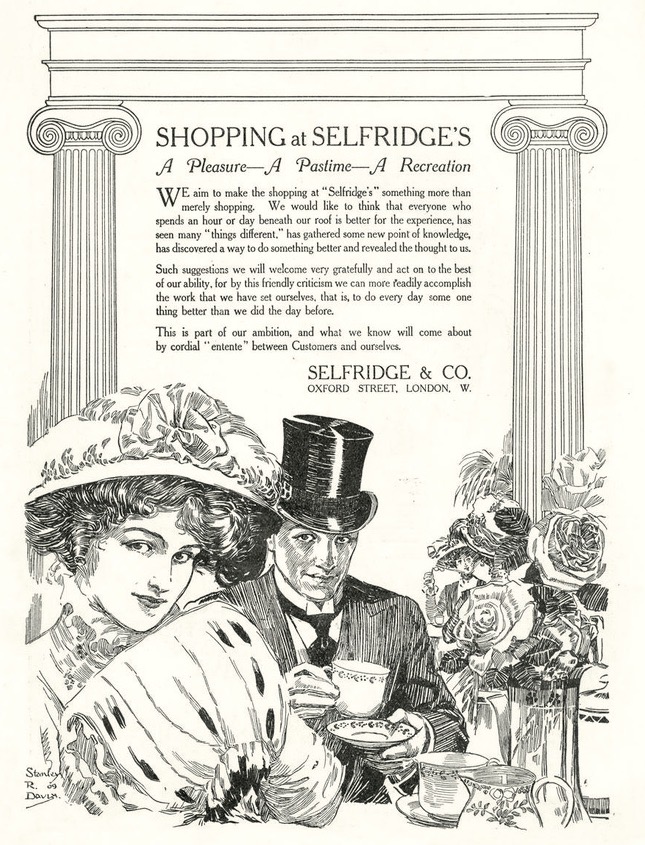
The first department stores had appeared in the 1850s and helped to create what Emile Zola called a “new religion,” the passion for consumption by the rising middle class which was enabled by the stores’ retailing revolution. A wide variety of cheaper goods at set prices such as furniture, fabrics and clothing could be bought under one roof.
The West End of London changed dramatically during this time. Architecturally grand department stores with large display windows were built on Regent Street and Oxford Street in particular.
The Whiteleys store in Bayswater, West London was a good example of such growth. Its Wikipedia page states:
The original Whiteleys department store was created by William Whiteley, who started a drapery shop at 31 Westbourne Grove in 1863. By 1867, it had expanded to a row of shops containing 17 separate departments. Dressmaking was started in 1868, and a house agency and refreshment room, the first ventures outside drapery, opened in 1872. By that time, 622 people were employed on the premises and a further 1,000 outside. By 1890 over 6,000 staff were employed in the business, most of them living in company-owned male and female dormitories…
Foundation of the WEARA


Fortunately, when the then 17-year-old WEARA acquired the Biffen Boathouse in 1897, RW Otter, the secretary of the West End ARA, was able to tell The Daily Telegraph of its history up to that point:
The first two clubs to be formed were Grove House RC (Messrs. Spencer, Turner and Co.) and the Alpha RC (Messrs. Meeking and Co. – today Messrs. Thomas Wallis and Co.)… For two or three years (from 1874) these two clubs raced with each other but in 1876 or ’77 Atlalanta RC (Messrs. Shoolbred and Co.) joined us. Until 1880, we continued to row matches in best boats over a course extending between Putney and Hammersmith and Barnes and Hammersmith Bridges, but in that year a decided and important step was taken. Other firms began to take an interest in sport, and being approached declared themselves ready and willing to become affiliated to some major body. The outcome of this desire was the establishment of the West-end Amateur Rowing Association.
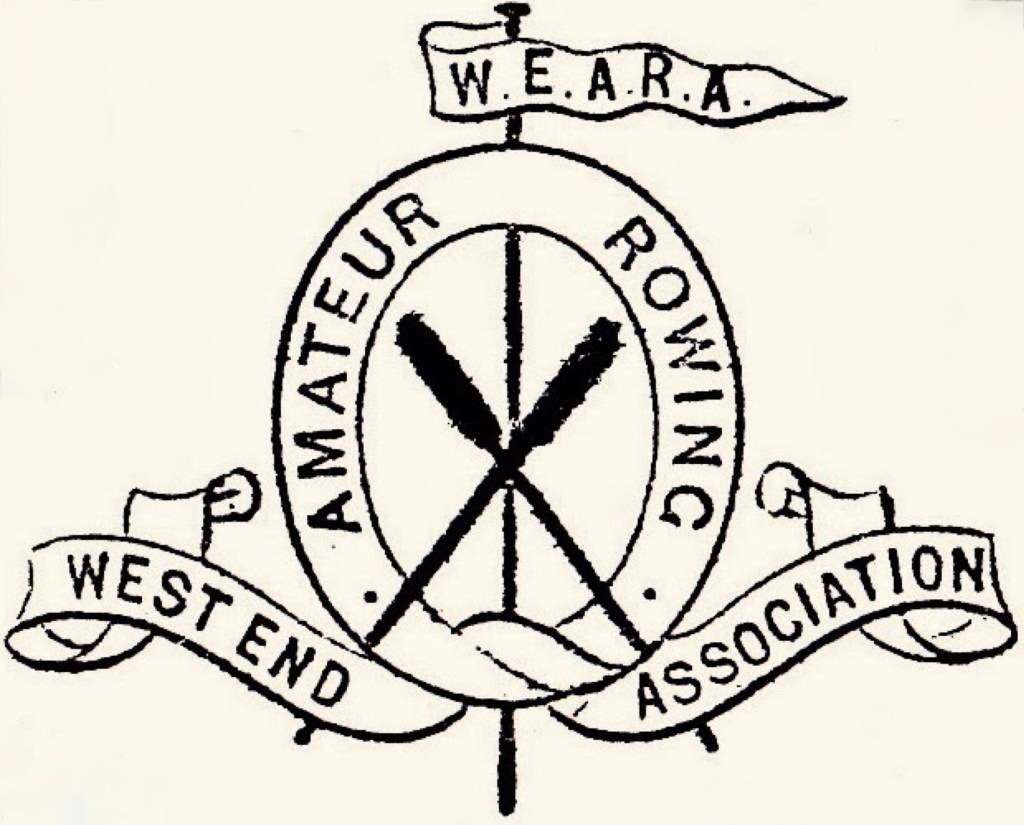
Otter continued:
It must be throughout borne in mind that these various clubs were formed independently of the heads of the firms… But the interest taken (by them) has been very marked…
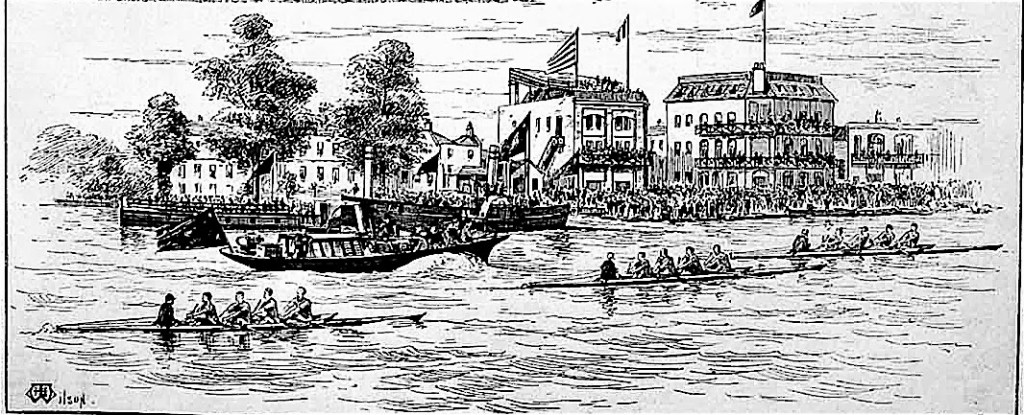
Otter: [In Grove House RC] a man can for 12s (60p) per year participate in every branch of athleticism patronised by it… It is not to be supposed that rowing solely occupies the attention of the men. Cricket, running, football and swimming, in their seasons, have each their substantial following…
To the average outsider [there is an] apparent lack of time to carry out these [activities]… Saturday afternoons can always be counted on and in the boating season night after night crews are out…
It can be no coincidence that the rise of the WEARA in the 1880s and 1890s ran parallel to the decline of the six-day-week and the growing adoption of the five-and-a-half day week. Factory, office and shop employees increasingly had Saturday afternoons off for rest, leisure or sport. There still could be no club rowing on Sunday which continued to be enforced as a holy day, a day of rest, even if you did not want to rest or to be holy.
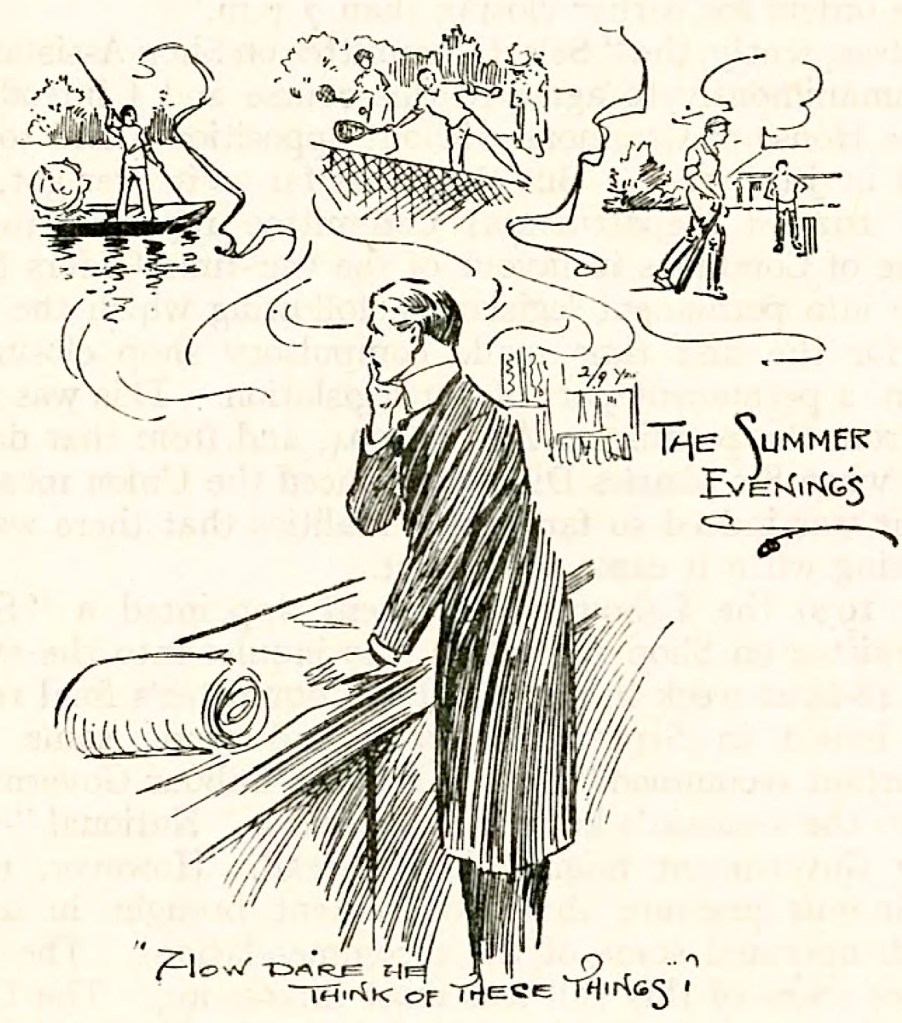
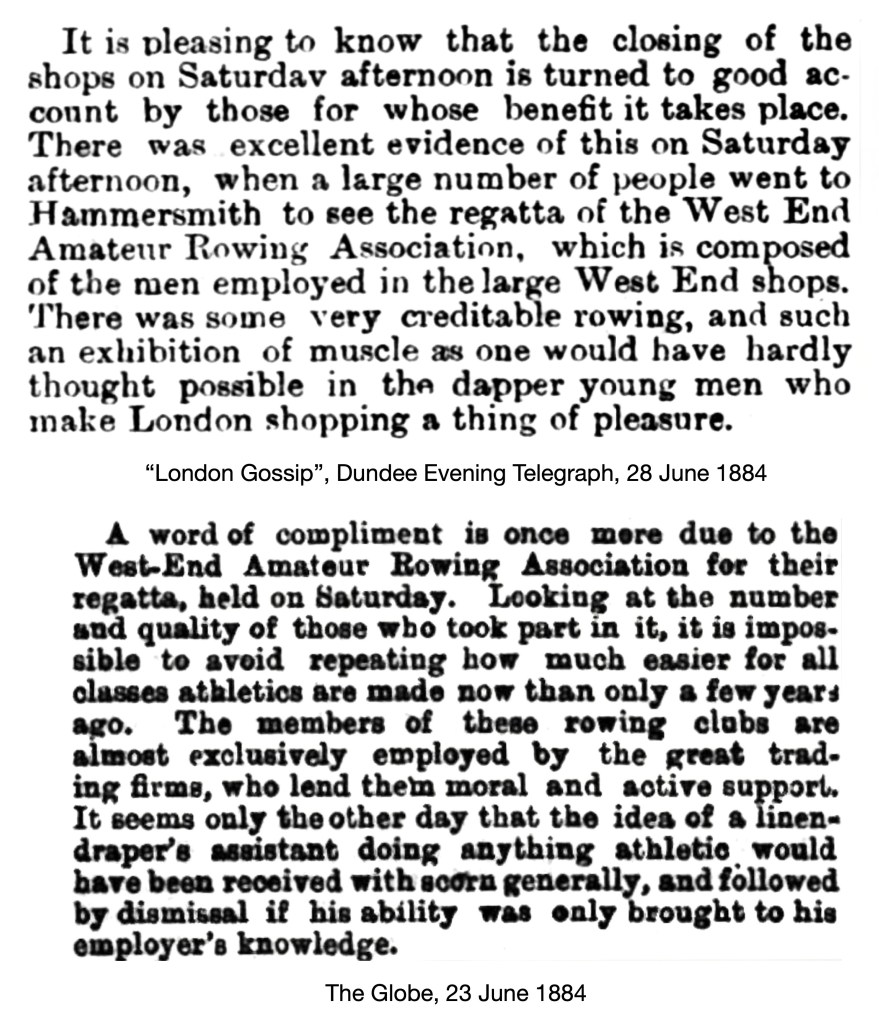
The Sporting Life of 21 May 1887 was very complimentary about the WEARA and also offered a suggestion, though one that was never taken up:
The West End Amateur Rowing Association is a most flourishing institution and there is some first-rate material among the numerous oarsmen who compose their crews. They confine themselves at present to races amongst their own members but might form a crew from the whole body that would be formidable opponents at the open amateur regattas…
Three pictures from editions of the Illustrated Sporting and Dramatic News of 1883, 1884 and 1888 show the interest taken in the rising WEARA.


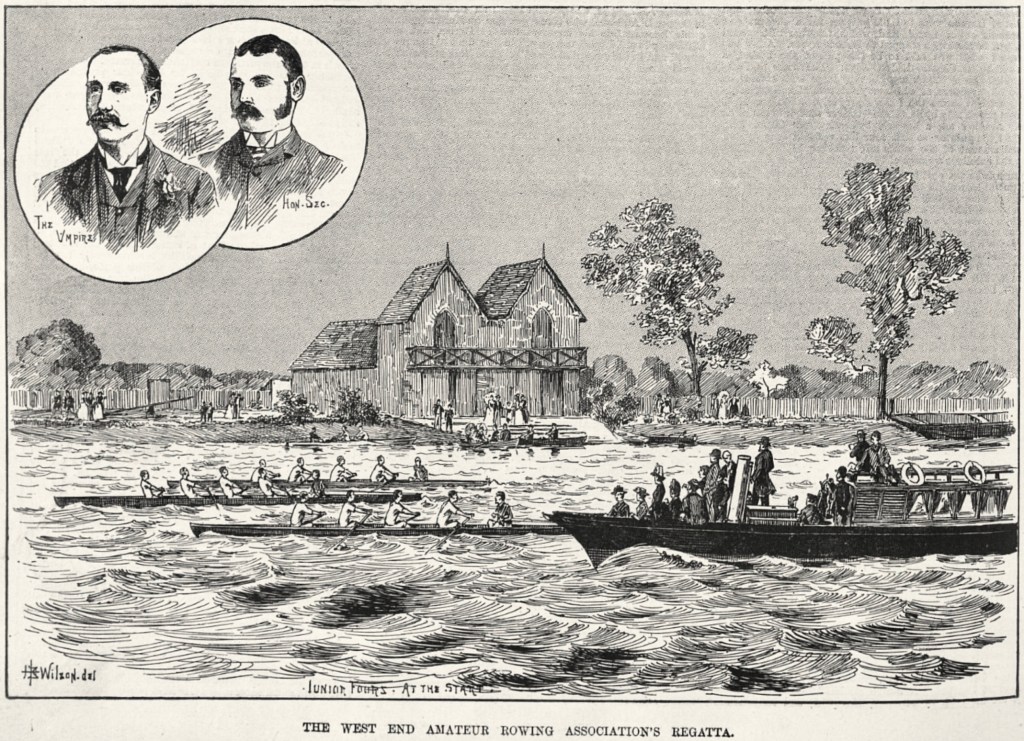
The Drapers Record of 19 June 1909 recorded that in that year WEARA membership was close to 1,000 and that the boathouse stored 30 eight-oared boats.

Wally Kinnear won Henley’s Diamond Sculls in 1910 and 1911, the Wingfield Sculls in 1910, 1911 and 1912, and the Olympic Sculls at Stockholm in 1912. He learned to row and scull with Cavendish RC, the rowing club of his employers, Debenham and Freebody. However, Cavendish was not affiliated to the Amateur Rowing Association (ARA) and so in 1906 Kinnear joined an ARA affiliated club, Kensington RC, so he could compete at Henley. The relationship between the ARA and the WEARA was a complicated one.
The WEARA and the ARA
In the early days, no WEARA clubs seemed to be affiliated to the self-proclaimed governing body of amateur rowing, the London-centric and Putney/Oxbridge dominated Amateur Rowing Association. Formed in 1882, the ARA was a staunch defender of the strange idea that anyone who worked with their hands could never be an amateur rower.
Thus, WEARA clubs could not take part in ARA regattas and were restricted to competing against others in the Association. At the time however, this non-affiliation was common. A letter to the Pall Mall Gazette in 1907 noted that the Rowing Almanack listed amateur 263 clubs, only 75 of which were affiliated to the ARA.
The question is, were the WEARA clubs strict upholders of the ARA’s unyielding definition of an amateur, something very necessary if any of them wished to affiliate to the wider association? Perhaps it is not possible to generalise.
A department store in particular would have employed a lot of people in offices and on the shop floor who were not “gentlemen” but who were not “manual workers” either and who should have just passed the ARA’s amateur test. However, if a store’s rowing club had allowed their manual workers such as warehousemen or delivery drivers to join, all would have been tainted with the indelible stain of so-called professionalism.
Perhaps The Sportsman of 26 December 1901 hinted at this:
(The) West End ARA is in a sense outside the pale of the usual ARA Associations…
Over twenty years later, the extract reproduced below from the Pall Mall Gazette of 3 January 1922 shows that the WEARA, Cygnet RC and others were still “outside the pale” or, in the Gazette’s post-war words, “in the No Man’s Land of rowing”. The “National Amateur Rowing Association” referred to by the Pall Mall Gazette was a rowing governing body that believed in amateurism as much as the ARA but whose definition of an amateur was the more sensible and simple one of someone who did not row for prize money or who did not work professionally with boats.

The evidence suggests however that the ARA took each club’s application for membership on its own merits. The entries for the Hammersmith Amateur Regatta of 1925 show entries by at least three WEARA clubs, Grove House (Spencer, Turner and Boldero), Arlington (Selfridges) and Gresham (Hosiers, J&R Morley). This suggests that they all must have been affiliated to the ARA, certainly Gresham had joined the ARA in 1906 when based at Chiswick. It was only in 1938 that the ARA’s manual labourer bar was lifted.
The WEARA boathouse is shown in the above YouTube video of newsreel of the 1923 Hammersmith Amateur Regatta.


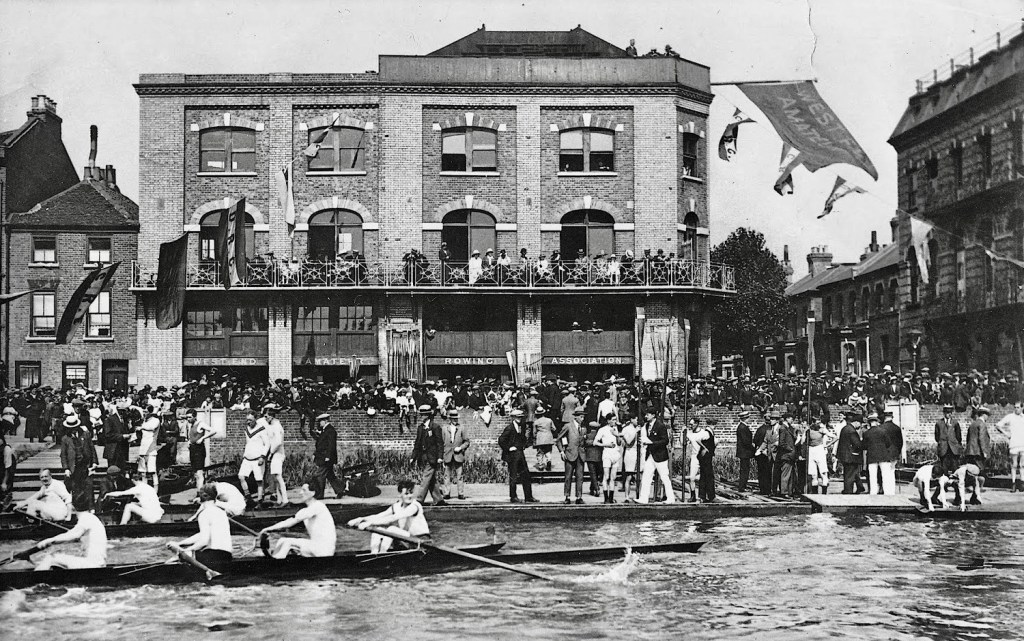
Sometime between 1909 and 1914, an extension had been added to the original Biffen Boathouse (to the left as viewed in the picture above). Boats were stored on ground level and also on the floor above. Those boats on the higher floor had to be precariously passed out of the upper doors and, as more of the boat protruded, those at the top had to quickly run downstairs to take the weight of the boat as it came down.
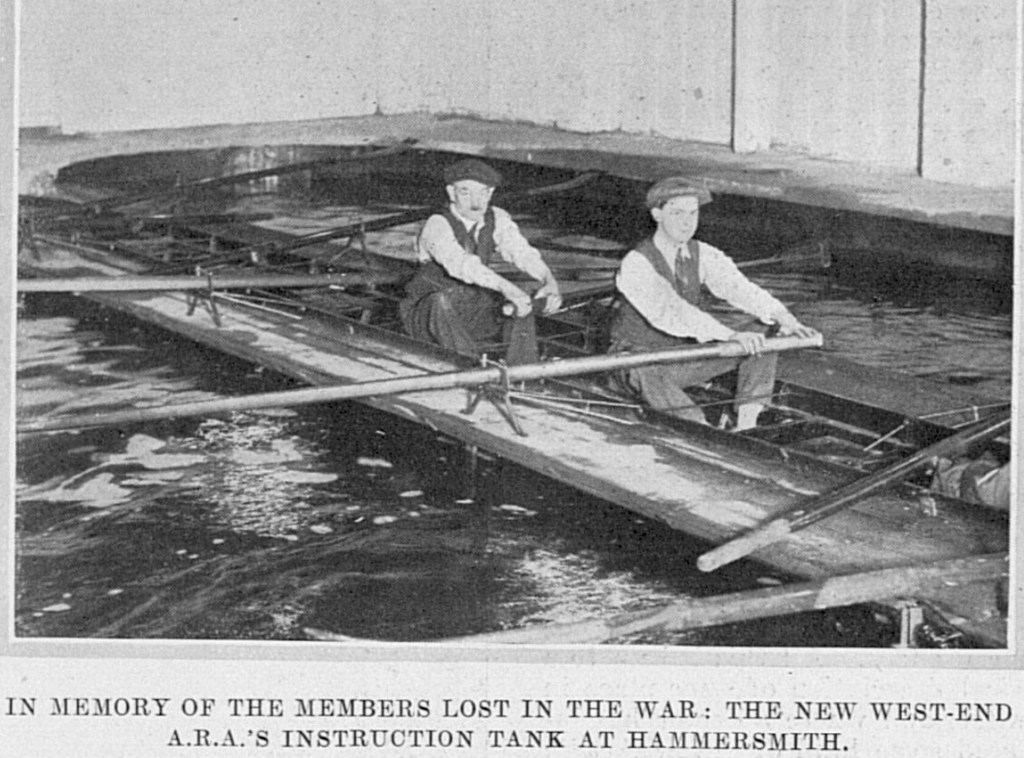
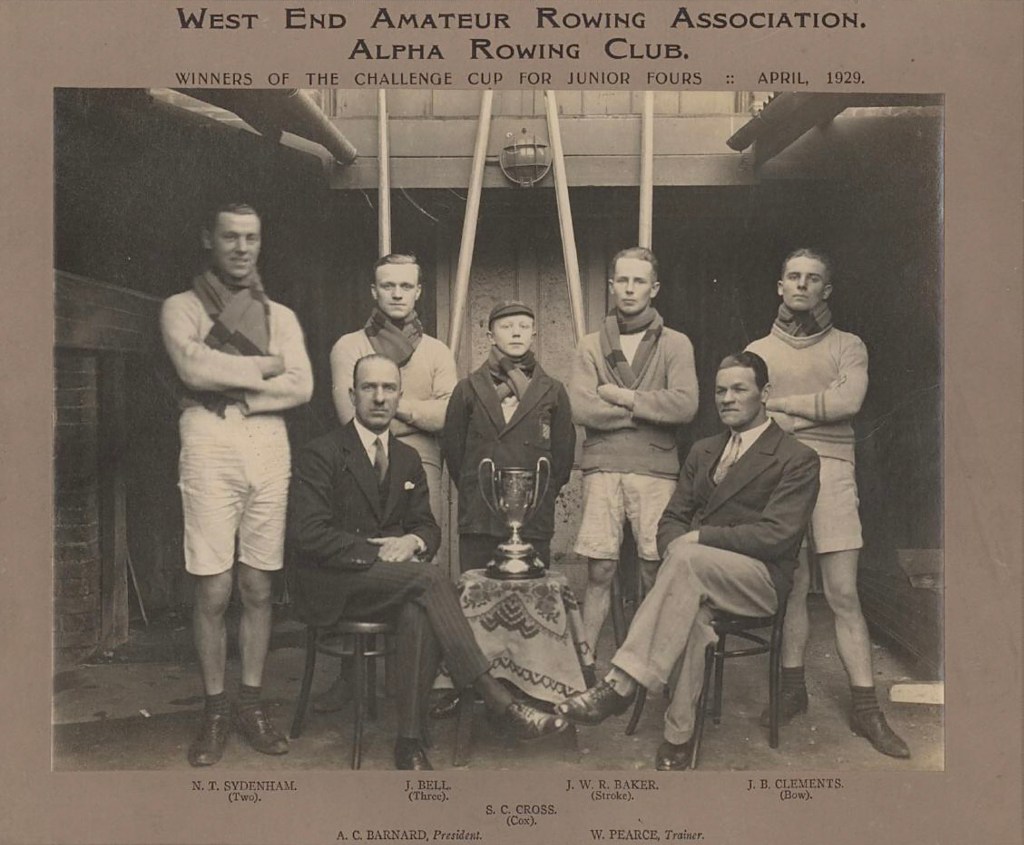

Decline 1945 – 1970.
Hammersmith’s Lower Mall suffered heavy bombing during the 1939 – 1945 War and the West End Boathouse was badly damaged.
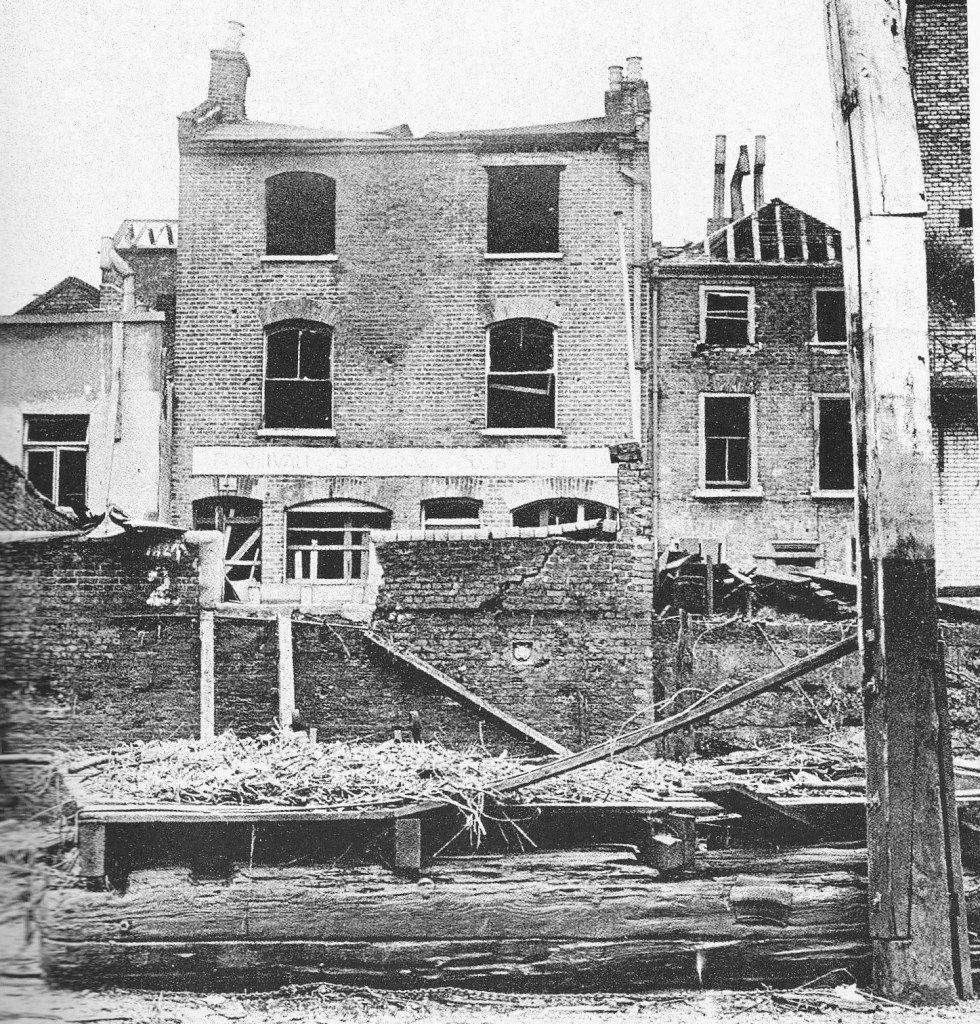
Post-war shortages of materials for repairing buildings meant that the West End Boathouse was not fully restored until November 1952 and the WEARA Regatta was only revived in 1955.
The world had changed greatly since 1939, notably in that many businesses dealing with post-war austerity and changing social attitudes could not or would not support extravagant staff social and sporting facilities any more. It seems that many business house rowing clubs simply never restarted again after the war – though this is difficult to accurately confirm as another change was that there was much less reporting of rowing matters by local and national newspapers.

Post-war, the West End Boathouse was the home of clubs including Sons of the Thames, Parkside, CAV (an Acton based engineering works), BASA (Building Apprentices and Students Association), London Irish, Oakleigh (Railways), London Transport District Line, London Transport Buses, Metropolitan Police, Blackfriars and, from 1957, Tideway Scullers. Of the old WEARA clubs, at least Kensington Argyle (Barkers), Clarence (Marples) and Harrodian survived into the 1950s.
I get the impression that the WEARA’s original founders and their immediate successors were not replaced by equally enthusiastic people with time and money to spare.
The West London Observer of 21 November 1952 records that the West End Boathouse Company ceased to let the building to the WEARA in May of that year. I think we have to conclude from this that the West End Amateur Rowing Association ceased to exist from this time. The Boathouse Company presumably then had individual agreements with each of the clubs using the building.

The Hammersmith & Shepherds Bush Gazette of 18 June 1964 interviewed veteran Hammersmith waterman and boatbuilder, Jack Colley. It wrote:
For something like 35 years Mr Colley has looked after the West End Boathouse… At one time there were 21 clubs using it… Today the boathouse is condemned and the four clubs left will either fold up or find somewhere else to go…
The Times of 6 January 1970:
The West End Boathouse, an essential link with Hammersmith rowing for over 70 years, has recently been classified by the Borough of Hammersmith as a “dangerous structure” and clubs have had to vacate the premises.
The boathouse has provided a home for many clubs unable to find their own building along the riverside. Local clubs with limited space in their boathouses, have found it essential for racking many of their boats and its eight-oared rowing tank has proved invaluable to Hammersmith clubs.
[In 1964] the owners of the site, the West End Boathouse Company, placed the boat-house on the market and the property went to a private buyer. Clubs were allowed to use the boathouse rent free but were responsible for rates and other outgoings.
As tenancy was subject to eight weeks notice, they were inhibited from meeting fully the mounting costs of repairs. The boathouse use fell into a sad state of repair and five clubs became extinct, being unable to recruit members to such unattractive surroundings.
In 1969, Mr Woodhouse, the owner, was served with a dangerous structure notice with the result that he demolished the building. Pictures of the cleared site are on the London Picture Archive website here, here and here.
On 5 February 1970, The Hammersmith & Shepherds Bush Gazette wrote that the boats from the West End Boathouse were being stored elsewhere in a place with no river access. A few of the clubs from the West End found other homes (notably Sons of the Thames and Tideway Scullers) but most disappeared forever.
Over the next four years, the local newspapers reported on several Hammersmith Council proposals for the site, some ambitious, some less so. The council talked of providing a temporary boathouse or making a compulsory purchase order, but these came to nothing. Finally, in April 1974, the site owner applied for permission to redevelop – but it took another ten years before new flats were finally built.


BASA was for young men learning the building trade. It was supported by Central Area 1 of the Master Builders Association and BASA stands for the Building Apprentices and Students Association Rowing Club.
Thanks, Teresa, we’ll change the text to include this information.
Really interesting article, thank you.
A small correction and an update that draws a couple of bits together if I may:
HSBC RC is still a business house rowing club and is not formally open, which has meant it could not access grants from British Rowing. Its members have had to be members of the HSBC Sports & Social Club (at Beckenham) and the vast majority have been employees or former employees of the bank. There was a requirement (from senior management) during my captaincy that all crews should have a majority of bank employee members. HSBCRC is, therefore, the last remaining business house rowing club to my knowledge. The bank owns the building and there is no rowing club lease at all.
That situation is, however, about to change. Further to your note about it being for sale, the boathouse is being sold to Harrodian School (which occupies the old Harrodian Club grounds you mention, and apparently outbid OUBC) for, I understand, about £3m. So there will be a Harrodian Rowing Club again, albeit of a different type. The transaction will complete at the end of the month and HSBC RC members spent much of this weekend clearing out the boathouse. Many will move to London RC, some to Barn Elms. It is a sad day – the end of a 145 year old club that has gone under a few names including City Bank Rowing Club, Joint Stock Bank Rowing Club, Midland Bank RC and HSBC RC.